API RP 2A-WSD-2007 Recommended Practice for Planning, Designing and Constructing Fixed Offshore Platforms-Working Stress Design
Подождите немного. Документ загружается.

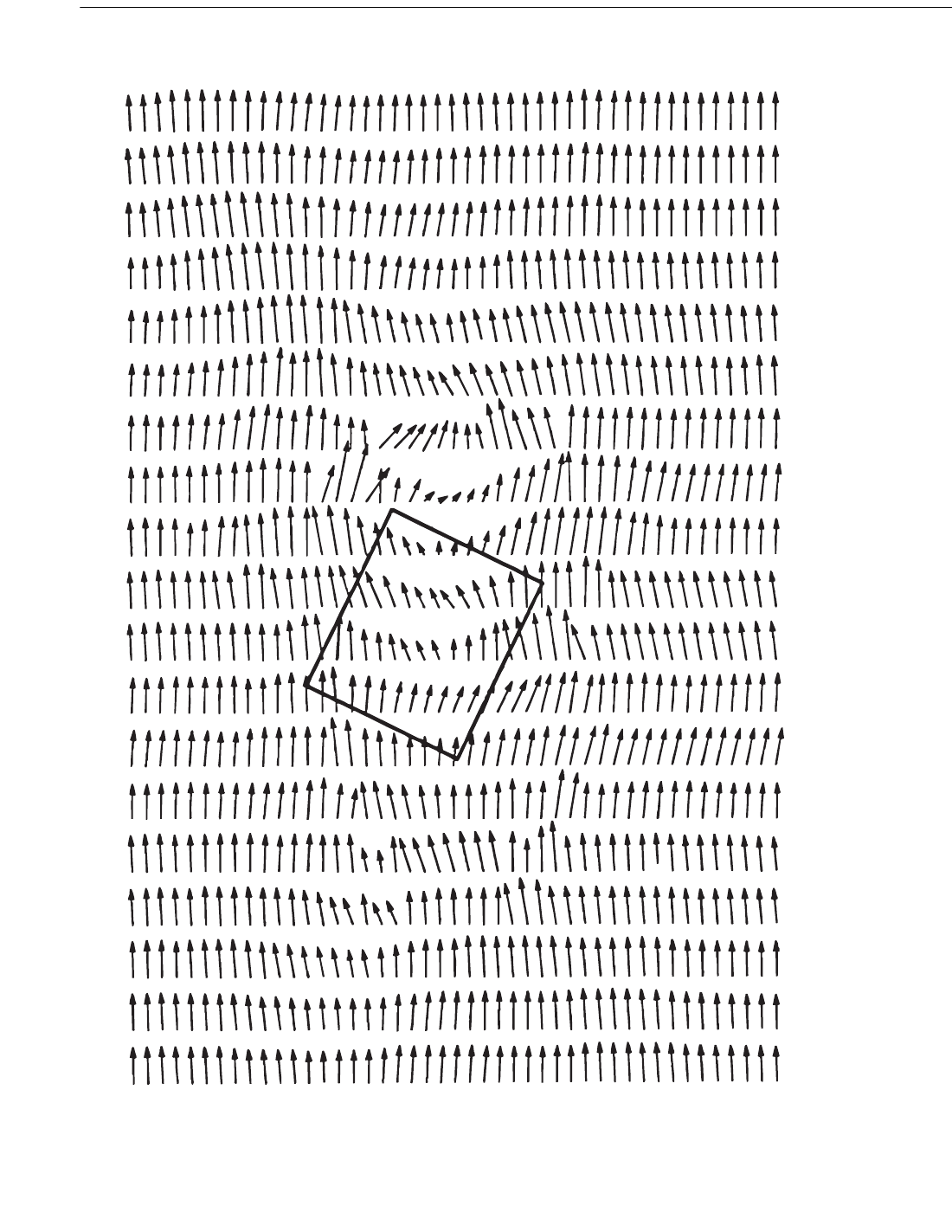
RECOMMENDED PRACTICE FOR PLANNING, DESIGNING AND CONSTRUCTING FIXED OFFSHORE PLATFORMS—WORKING STRESS DESIGN 139
Figure C2.3.1-1—Current Vectors Computed from Doppler Measurements at 60 ft
on the Bullwinkle Platform (100 cm/s →)
Copyright American Petroleum Institute
Provided by IHS under license with API
Licensee=Indonesia location/5940240008
Not for Resale, 10/22/2008 00:07:12 MDT
--`,,```,,,`,,,,,,,,,,,,,,`,``,`-`-`,,`,,`,`,,`---

140 API RECOMMENDED PRACTICE 2A-WSD
are within +1 to –4 percent of those produced by the exact
solution on a typical drag-dominant structure subjected to
representative waves and current profiles.
Another acceptable approximate model for many applica-
tions is one that uses a linearly stretched current profile, with
z + d = (z´ + d) (d + η)/d
The stretched current profiles from the two models are
compared qualitatively in Figure C2.3.1-2 for typical
sheared and slab current profiles under a wave crest. The
linearly stretched current produces global loads on a typical
drag-dominant platform that are nearly as accurate as those
produced by the nonlinearly stretched current, being within
0 to –6 percent of loads produced by the exact solution.
However, it does not simulate the combined wave/current
velocity profile from the exact solution as faithfully as non-
linear stretching.
Vertical extrapolation of the input current profile above
mean water level produces reasonably accurate estimates of
global loads on drag-dominant platforms in most cases. In
particular, for a slab profile thicker than about 50 m, like the
recommended profiles in Section 2.3.4, vertical extrapolation
produces nearly the same result as nonlinear stretching, as
illustrated in Figure C2.3.1-2. However, if the specified pro-
file U
c
(z) has a very high speed at mean water level, sheared
to much lower speeds just below mean water level, the global
force may be overestimated (by about 8 percent in a typical
application).
Another approximate model is the linearly stretched model
described above, adjusted so that the total momentum in the
stretched profile from the seafloor to the wave surface equals
that in the specified profile from the seafloor to mean water
level. This procedure is not supported by the theoretical anal-
yses of Dalrymple and Heideman (1989) or Eastwood and
Watson (1989).
If the current is not in the same direction as the wave, the
methods discussed above may still be used, with one modifi-
cation. Both the in-line and normal components of current
would be stretched, but only the in-line component would be
used to estimate T
app
for the Doppler-shifted wave.
While no exact solution has been developed for irregular
waves, the wave/current solution for regular waves can be
logically extended. In the first two approximations described
above for regular waves, the period and length of the regular
wave should be replaced with the period and length corre-
sponding to the spectral peak frequency.
C2.3.1b6 Marine Growth
All elements of the structure (members, conductors, risers,
appurtenances, etc.) are increased in cross-sectional area by
marine growth. The effective element diameter (cross-sec-
tional width for non-circular cylinders, or prisms) is D = D
c
+
2t, where D
c
is the “clean” outer diameter and t is the average
growth thickness that would be obtained by circumferential
measurements with a 1 inch to 4 inch-wide tape. An addi-
tional parameter that affects the drag coefficient of elements
with circular cross-sections is the relative roughness, e = k/D,
where k is the average peak-to-valley height of “hard” growth
organisms. Marine growth thickness and roughness are illus-
trated in Figure C.2.3.1-3 for a circular cylinder. Marine
organisms generally colonize a structure soon after installa-
tion. They grow rapidly in the beginning, but growth tapers
off after a few years. Marine growth has been measured on
structures in many areas but must be estimated for other
areas.
C2.3.1b7 Drag and Inertia Coefficients
In the ocean environment, the forces predicted by Mori-
son’s equation are only an engineering approximation. Mori-
son’s equation can match measured drag and inertia forces
reasonably well in any particular half wave cycle with con-
stant C
d
and C
m
, but the best fit values of C
d
and C
m
vary
from one half wave cycle to another. Most of the variation in
C
d
and C
m
can be accounted for by expressing C
d
and C
m
as
functions of
Relative surface roughness e = k/D
Reynolds number R
m
= U
m
D/ν
Keulegan-Carpenter number K = 2U
m
T
2
/D
Current/wave velocity ratio r = V
1
/U
mo
Member orientation
Here U
m
is the maximum velocity (including current) nor-
mal to the cylinder axis in a half wave cycle, T
2
is the dura-
tion of the half wave cycle, V
1
is the in-line (with waves)
current component, U
mo
is the maximum wave-induced
orbital velocity, D is effective diameter (including marine
growth), ν is the kinematic viscosity of water, and k is the
absolute roughness height.
Surface Roughness. The dependence of C
ds
, the steady-flow
drag coefficient at post-critical Reynolds numbers, on relative
surface roughness, is shown in Figure C2.3.1-4, for “hard”
roughness elements. All the data in this figure have been
adjusted, if necessary, to account for wind tunnel blockage
and to have a drag coefficient that is referenced to the effec-
tive diameter D, including the roughness elements.
Natural marine growth on platforms will generally have e
> 10
–3
. Thus, in the absence of better information on the
expected value of surface roughness and its variation with
depth for a particular site, it is reasonable to assume C
ds
=
1.00 to 1.10 for all members below high tide level. One
would still need to estimate the thickness of marine growth
that will ultimately accumulate in order to estimate the
Copyright American Petroleum Institute
Provided by IHS under license with API
Licensee=Indonesia location/5940240008
Not for Resale, 10/22/2008 00:07:12 MDT
--`,,```,,,`,,,,,,,,,,,,,,`,``,`-`-`,,`,,`,`,,`---
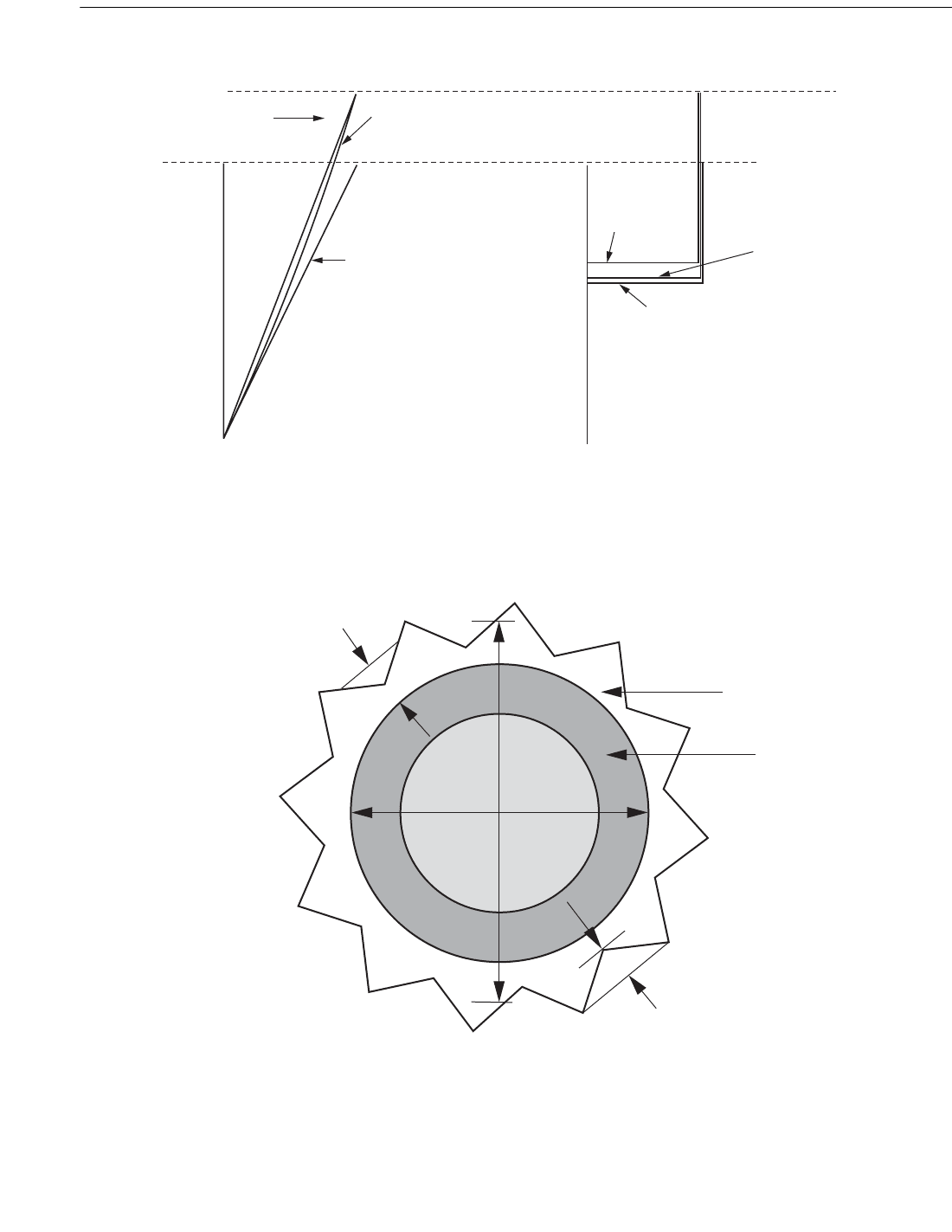
RECOMMENDED PRACTICE FOR PLANNING, DESIGNING AND CONSTRUCTING FIXED OFFSHORE PLATFORMS—WORKING STRESS DESIGN 141
Figure C2.3.1-2—Comparison of Linear and Nonlinear Stretching of Current Profiles
Figure C2.3.1-3—Definition of Surface Roughness Height and Thickness
Shear profile
Linear
stretch
Nonlinear
stretch
Input
profile
Linear
stretch
Nonlinear
stretch
Input
profile
MWL
Crest
Slab profile
D
k
Hard growth
Pipe
e = k/D
D = D
c
+ 2t
t
D
c
Copyright American Petroleum Institute
Provided by IHS under license with API
Licensee=Indonesia location/5940240008
Not for Resale, 10/22/2008 00:07:12 MDT
--`,,```,,,`,,,,,,,,,,,,,,`,``,`-`-`,,`,,`,`,,`---

142 API RECOMMENDED PRACTICE 2A-WSD
effective diameter D. For members above high tide level, a
reasonable estimate of surface roughness is k = 0.002 inches
(0.05 mm), which will give C
ds
in the range 0.6 to 0.7 for
typical diameters.
All the data in Figure C2.3.1-4 are for cylinders that are
densely covered with surface roughness elements. Force mea-
surements (Kasahara and Shimazaki, 1987; Schlichting,
1979) show that there is little degradation in the effectiveness
of surface roughness for surface coverage as sparse as 10%,
but that roughness effects are negligible for surface coverage
less than 3%.
The effect of soft, flexible growth on C
ds
is poorly under-
stood. Tests run by Nath (1987) indicate that (a) soft, fuzzy
growth has little effect, C
ds
being determined predominantly
by the underlying hard growth; and (b) anemones and kelp
produce drag coefficients similar to those for hard growth.
For cylindrical members whose cross section is not circu-
lar, C
ds
may be assumed to be independent of surface rough-
ness. Suitable values are provided by DnV (1977).
Surface roughness also affects the inertia coefficient in
oscillatory flow. Generally, as C
d
increases with roughness,
C
m
decreases. More information is provided in subsequent
discussions.
Reynolds Number. The force coefficients for members
whose cross sections have sharp edges are practically inde-
pendent of Reynolds number. However, circular cylinders
have coefficients that depend on Reynolds number.
Fortunately, for most offshore structures in the extreme
design environment, Reynolds numbers are well into the
post-critical flow regime, where C
ds
for circular cylinders is
independent of Reynolds number. However, in less severe
environments, such as considered in fatigue calculations,
some platform members could drop down into the critical
flow regime. Use of the post critical C
ds
in these cases would
be conservative for static wave force calculations but noncon-
servative for calculating damping of dynamically excited
structures.
In laboratory tests of scale models of platforms with circu-
lar cylindrical members, one must be fully aware of the
dependence of C
ds
on Reynolds number. In particular, the
scale of the model and the surface roughness should be cho-
sen to eliminate or minimize Reynolds number dependence,
and the difference between model-scale and full-scale C
ds
should be considered in the application of model test results
to full-scale structures. Further guidance on the dependence
of circular cylinder C
ds
on Reynolds number can be found in
Achenbach (1971), Hoerner (1965), and Sarpkaya and Isaac-
son (1981).
Keulegan-Carpenter Number. This parameter is a measure
of the unsteadiness of the flow; it is proportional to the dis-
tance normal to the member axis traveled by an undisturbed
fluid particle in a half wave cycle, normalized by the member
diameter. For a typical full-scale jacket structure in design
storm conditions, K is generally greater than 40 for members
in the ‘wave zone’, and drag force is predominant over inertia
force. On the other hand, for the large-diameter columns of a
typical gravity structure, K may be less than 10 and inertia
force is predominant over drag force.
The parameter K is also a measure of the importance of
“wake encounter” for nearly vertical (within 15° of vertical)
members in waves. As the fluid moves across a member, a
wake is created. When oscillatory flow reverses, fluid parti-
cles in the wake return sooner and impact the member with
greater velocity than undisturbed fluid particles. For larger K,
the wake travels farther and decays more before returning to
the cylinder and, furthermore, is less likely to strike the cylin-
der at all if the waves are multidirectional or there is a compo-
nent of current normal to the principal wave direction. For
very large K, wake encounter can be neglected. For smaller
K, wake encounter amplifies the drag force for nearly vertical
members above its quasi-steady value estimated from undis-
turbed fluid velocities.
Figure C2.3.1-5 shows data for the drag coefficient C
d
that
are most appropriate for calculating loads on nearly vertical
members in extreme storm environments. All these data were
obtained in the post-critical flow regime, in which C
ds
is
practically independent of Reynolds number. All account for
wave spreading, that is, all have two components of motion
normal to the member axis. All except the ‘figure 8’ data
implicitly account for random wave motion. The field data
also naturally include an axial component of motion and, to
some extent, a steady current. The data for smooth and rough
cylinders are reasonably well represented by a single curve in
Figure C2.3.1-5, for K > 12, with K normalized by C
ds
, as
suggested by the far-field, quasi-steady wake model of Beck-
mann and McBride (1968).
Figure C2.3.1-6 shows drag coefficient data for K < 12,
which are more appropriate for calculating loads on nearly
vertical members in less extreme sea states and drag damping
in earthquake-excited motion, for example. For K < 12, the
smooth and rough cylinder data are similar if K is not normal-
ized by C
ds
. The data of Sarpkaya (1986) do not agree well
with the curves in Figure C2.3.1-6, presumably because of
the relatively low Reynolds number in his tests for the lowest
values of K and because of the lack of wave spreading in his
tests for the higher values of K.
It should be noted that the symbols shown in Figure
C2.3.1-5 do not represent individual data points. Rather, they
represent values from a curve fitted through a scatter of data
points. In designing a structure consisting of a single isolated
column, one should perhaps account for the scatter in the C
d
data. In this regard, the data of Sarpkaya (1986) for one-
dimensional, sinusoidally oscillating motion, which are nota-
bly omitted from Figure C2.3.1-5, represent a reasonable
upper bound. However, for a structure consisting of many
members, the scatter in C
d
can probably be neglected, as the
Copyright American Petroleum Institute
Provided by IHS under license with API
Licensee=Indonesia location/5940240008
Not for Resale, 10/22/2008 00:07:12 MDT
No reproduction or networking permitted without license from IHS
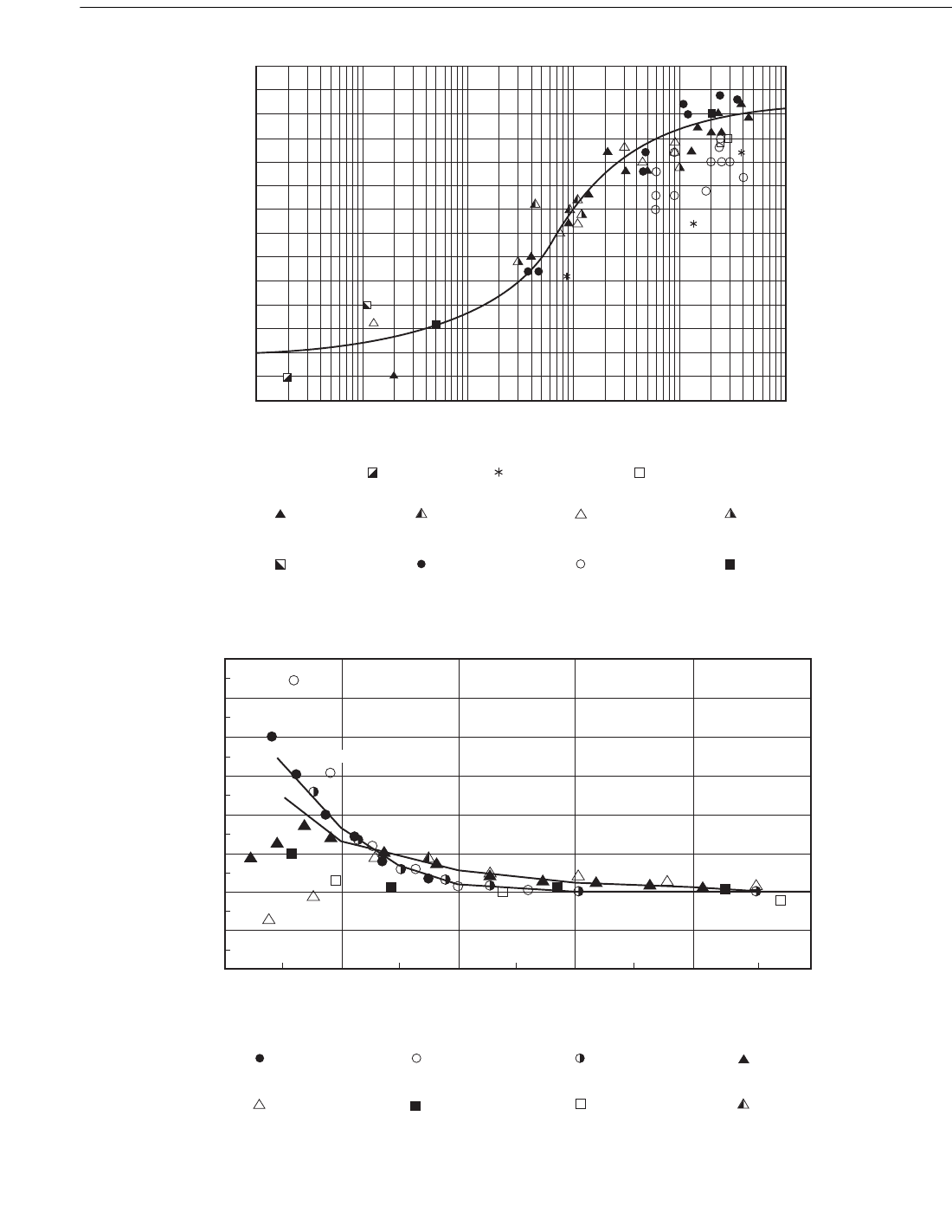
RECOMMENDED PRACTICE FOR PLANNING, DESIGNING AND CONSTRUCTING FIXED OFFSHORE PLATFORMS—WORKING STRESS DESIGN 143
Figure C2.3.1-4—Dependence of Steady Flow Drag Coefficient on Relative Surface Roughness
Figure C2.3.1-5—Wake Amplification Factor for Drag Coefficient as a Function of K/C
ds
1.2
1.1
1
0.9
0.8
0.7
0.6
0.5
CDS
1E-06 1E-05 0.0001 0.001 0.01 0.1
e
Jones (1989) Blumberg (1961) Wolfram (1985)
Miller (1976) Szechenyl (1975) Achenbach (1971, 1981) Want (1986)
Roshko (1961) Norton (1983) Nath (1987) Rodenbusch (1983)
Rodenbusch (1983), CDS = 0.66
random directional
Rodenbusch (1983), CDS = 1.10
Figure 8
Rodenbusch (1983), CDS = 0.66
Figure 8
Heldeman (1979), CDS = 1.00 Heldeman (1979), CDS = 0.68 Bishop (1985), CDS = 0.66
Rodenbusch (1983), CDS = 1.10
random directional
Ohmart & Gratz (1979), CDS = 0.60
2.2
2
1.8
1.6
1.4
1.2
1
0.8
0.6
0 20 40 60 80 100
K/CDS
Lab data
Field data
Copyright American Petroleum Institute
Provided by IHS under license with API
Licensee=Indonesia location/5940240008
Not for Resale, 10/22/2008 00:07:12 MDT
--`,,```,,,`,,,,,,,,,,,,,,`,``,`-`-`,,`,,`,`,,`---

144 API RECOMMENDED PRACTICE 2A-WSD
deviations from the mean curve are uncorrelated from mem-
ber to member (see Heideman et al., 1979).
Figures C2.3.1-7 and C2.3.1-8 show data for the inertia
coefficient C
m
for a nearly vertical circular cylinder. Figure
C2.3.1-7 shows that C
m
for both smooth and rough cylin-
ders approaches the theoretical value of 2.0 for K ≤ 3. For K
> 3, with the onset of flow separation, C
m
begins to
decrease. With the exception of Sarpkaya’s rough cylinder
data, which exhibit a pronounced drop (‘inertia crisis’) in
C
m
at K ≈ 12, it appears that a single sloping line is adequate
for both smooth and rough cylinders, up to K ≈ 12, beyond
which smooth and rough cylinder data begin to diverge. In
Figure C2.3.1-8, the single line from Figure C2.3.1-7 is seen
to split into two lines because K is divided by C
ds
= 0.66 for
smooth cylinders and C
ds
= 1.1 for rough cylinders. The
vale of C
m
is taken as 1.6 for smooth cylinders and 1.2 for
rough cylinders for K/C
ds
≥ 17.
Although Figures C2.3.1-5 through C2.3.1-8 are based on
circular cylinder data, they are also applicable to non-circular
cylinders, provided the appropriate value of C
ds
is used, and
provided C
m
is multiplied by C
mo
/2, where C
mo
is the theoret-
ical value of C
m
for the non-circular cylinder as K → 0.
Furthermore, while Figs. C2.3.1-5 through C2.3.1-8 were
developed for use with individual, deterministic waves, they
can also be used for random wave analysis (either time or fre-
quency domain) of fixed platforms by using significant wave
height and spectral peak period to calculate K.
Current/Wave Velocity Ratio. The effect of a steady in-line
current added to oscillatory motion is to push C
d
toward C
ds
,
its steady flow value. Data show that, for practical purposes,
C
d
= C
ds
when the current/wave velocity ratio r is greater than
0.4. For r < 0.4, the effect of a steady in-line current can be
accommodated by modifying the Keulegan-Carpenter num-
ber. A first-order correction would be to multiply K due to
wave alone by (1 + r)2θ
*
/π, where θ
*
= arctan [ , –r].
A current component normal to the wave direction also
drives C
d
toward C
ds
, since it reduces the impact of wake
encounter. Data show that, for practical purposes, C
d
= C
ds
for V
N
T
2
/C
ds
D > 4. On the other hand, wake encounter has
nearly its full impact for V
N
T
2
/C
ds
D < 0.5.
Member Orientation: For members that are not nearly verti-
cal, the effect of wake encounter, as characterized by the K
dependence in Figs. C2.3.1-5 through C2.3.1-8, is small. For
horizontal and diagonal members, it is sufficient for engineer-
ing purposes to use the theoretical value of C
m
at K → 0 and
the steady-flow value of C
d
= C
ds
at K → ∞.
C2.3.1b8 Conductor Shielding Factor
The empirical basis for the shielding wave force reduction
factor for conductor arrays is shown in Figure C2.3.1-9. Data
from flow directions perfectly aligned with a row or column
of the array are excluded, for conservatism.
The data in Figure C2.3.1-9 are from steady flow tests and
oscillatory flow tests at very high amplitudes of oscillation.
Thus the factor is strictly applicable only in a steady current
with negligible waves or near the mean water level in very
large waves. The data of Heideman and Sarpkaya (1985)
indicate that the factor is applicable if A/S > 6, where A is the
amplitude of oscillation and S is the center-to-center spacing
of the conductors in the wave direction. The data of Reed et
al. (1990) indicate that range of applicability can be expanded
to A/S > 2.5. For lower values of A/S, there is still some
shielding, until A/S < 0.5 (Heideman and Sarpkaya, 1985).
With A ≈ U
mo
T
app
/2π, where U
mo
and T
app
are defined in
C2.3.1b7 and C2.3.1b1, respectively, the approximate shield-
ing regimes are:
• A/S > 2.5, asymptotic shielding, factor from Figure
C2.3.1-9.
• A/S < 0.5, no shielding factor = 1.0.
• 0.5 < A/S < 2.5, partial shielding.
In the absence of better information, the shielding factor in
the partial shielding regime can be linearly interpolated as a
function of A/S. Waves considered in fatigue analyses may
lie in the partial shielding regime.
C2.3.1b9 Hydrodynamic Models for
Appurtenances
The hydrodynamic model of a structure is used for the cal-
culation of wave forces which represent the forces on the
actual structure. The model need not explicitly include every
element of the structure provided the dimensions and/or force
coefficients for the included elements account for the contri-
bution of the forces on the omitted elements. The hydrody-
namic model should account for the effects of marine growth
and for flow interference effects (blockage and shielding)
where appropriate.
Appurtenances include sub-structures and elements such as
boat landings, fenders or bumpers, walkways, stairways,
grout lines, and anodes. Though it is beyond the scope of this
commentary to provide modeling guidance for every con-
ceivable appurtenance, some general guidance is provided.
Boat landings are sub-structures generally consisting of a
large number of closely spaced tubular members, particularly
on some of the older designs. If the members are modeled
individually, shielding effects, depending upon the wave
direction, can be accounted for in a manner similar to that for
conductor arrays. Another option is to model a boat landing
as either a rectangular solid or as one or more plates, with
directionally dependent forces. Some guidance for coeffi-
cients for solid shapes and plates can be found in Det norske
Veritas (1977).
Conductor guide frames may also be modeled as rectangu-
lar solids and sometimes as plates. In either case, different
coefficients are appropriate for vertical and horizontal forces.
1 r
2
–
07
Copyright American Petroleum Institute
Provided by IHS under license with API
Licensee=Indonesia location/5940240008
Not for Resale, 10/22/2008 00:07:12 MDT
--`,,```,,,`,,,,,,,,,,,,,,`,``,`-`-`,,`,,`,`,,`---
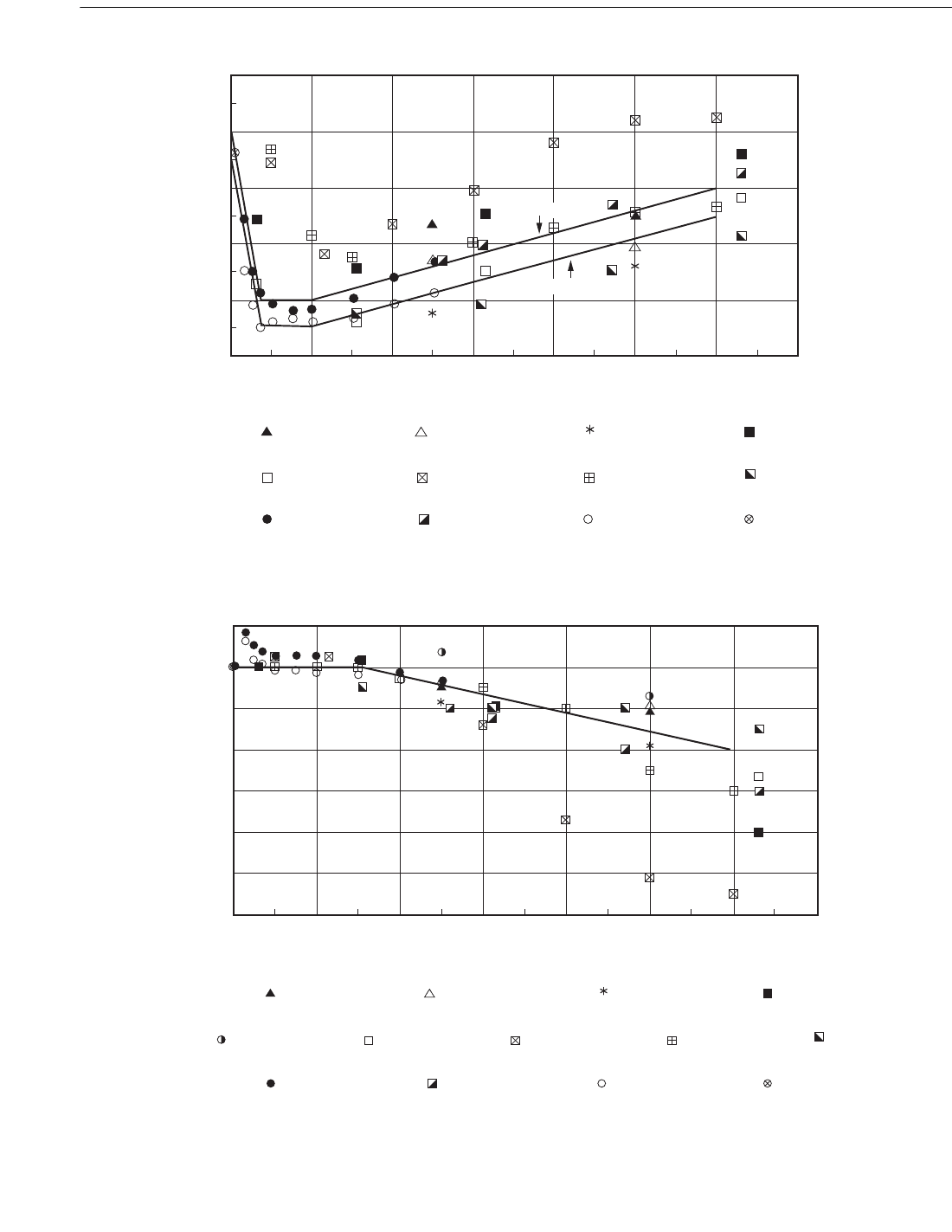
RECOMMENDED PRACTICE FOR PLANNING, DESIGNING AND CONSTRUCTING FIXED OFFSHORE PLATFORMS—WORKING STRESS DESIGN 145
Figure C2.3.1-6—Wake Amplification Factor for Drag Coefficient as a Function of K
Figure C2.3.1-7—Inertia Coefficient as a Function of K
Rodenbusch (1983), CDS = 0.66
sinusoidal
Sarpkaya (1986), CDS = 1.10 Sarpkaya (1986), CDS = 0.65
Rodenbusch (1983), CDS = 1.10
random directional
Rodenbusch (1983), CDS = 0.66
random directional
Bearman (1985), CDS = 0.60
Rodenbusch (1983), CDS = 1.10
sinusoidal
Garrison (1990), CDS = 0.65
Marin (1987), CDS = 1.10 Garrison (1990), CDS = 1.10 Marin (1987), CDS = 0.60
Iwaki (1991), CDS = 1.10
2.5
2
1.5
1
0.5
0
0246810
12 14
K
CD/CDS
Rough (C
ds
= 1.2)
Smooth (C
ds
= 0.6)
Rodenbusch (1983), CDS = 0.66
sinusoidal
Bishop (1985), CDS = 0.66
Sarpkaya (1986), CDS = 1.10 Sarpkaya (1986), CDS = 0.65
Rodenbusch (1983), CDS = 1.10
random directional
Rodenbusch (1983), CDS = 0.66
random directional
Bearman (1985), CDS = 0.60
Rodenbusch (1983), CDS = 1.10
sinusoidal
Garrison (1990), CDS = 0.65
Marin (1987), CDS = 1.10 Garrison (1990), CDS = 1.10 Marin (1987), CDS = 0.60
Iwaki (1991), CDS = 1.10
2.2
2
1.8
1.8
1.4
1.2
1
0.8
0246810
12 14
K
CM
Copyright American Petroleum Institute
Provided by IHS under license with API
Licensee=Indonesia location/5940240008
Not for Resale, 10/22/2008 00:07:12 MDT
--`,,```,,,`,,,,,,,,,,,,,,`,``,`-`-`,,`,,`,`,,`---

146 API RECOMMENDED PRACTICE 2A-WSD
Large fenders or boat bumpers and their supporting mem-
bers are usually modeled as individual members. They may
be treated as non-structural members provided that experi-
ence has shown their design to be adequate for their intended
purpose. Walkways, stairways, and grout lines may be mod-
eled as equivalent circular members though they are some-
times ignored where experience has proven the acceptability
of such action.
The treatment of anodes depends somewhat upon the num-
ber and size of the anodes on the structure. Anodes are often
ignored in the hydrodynamic model where experience has
shown that their wave force contribution is negligible. If they
are included, they can be modeled as equivalent circular cyl-
inders. Alternatively, anode wave forces may be approxi-
mated by increasing the diameters and/or force coefficients of
the member to which they are attached.
C2.3.1b10 Morison Equation
The use of the local acceleration rather than the total (local
plus convective) acceleration in the inertia term of Morison’s
equation is the subject of ongoing debate. There have been
several publications on this topic in recent years (Manners
and Rainey, 1992; Madsen, 1986; Sarpkaya and Isaacson,
Section 5.3.1, 1981; Newman, 1977). These publications all
conclude that the total acceleration should be used. However,
it must be noted that these publications all assume unrealisti-
cally that the flow does not separate from the cylinder. Realis-
tically, except for very small amplitudes of oscillation (K <
3), the flow separates on the downstream side of the cylinder,
creating a wake of reduced velocity. The local change in
velocity across the cylinder due to the convective acceleration
in the undisturbed far-field flow is generally much less than
the change in velocity due to local flow separation, as implied
in the paper by Keulegan and Carpenter (1958). The convec-
tive acceleration may also be nearly in phase with the locally
incident flow velocity, which leads the undisturbed far field
velocity in oscillatory flow because of “wake encounter”
(Lambrakos, et al., 1987). Therefore, it could be argued that
the convective acceleration should be neglected, either
because it is small relative to local velocity gradients due to
flow separation or because it is already implicitly included in
drag coefficients derived from measurements of local force in
separated flow. As a practical matter, the convective accelera-
tion exceeds 15% of the local acceleration only in steep
waves, for which inertia force is generally much smaller than
drag force (Sarpkaya and Isaacson, 1981).
Only the components of velocity and acceleration normal
to the member axis are used in computing drag and inertia
forces, based on the “flow independence,” or “cross-flow,”
principle. This principle has been verified in steady subcriti-
cal flow by Hoerner (1965) and in steady postcritical flow by
Norton, Heideman, and Mallard (1983). The data of Sarp-
kaya, et al. (1982), as reinterpreted by Garrison (1985), have
shown the flow independence principle to be also for inertia
forces in one-dimensional oscillatory flow. Therefore, it is
reasonable to assume that the flow independence principle is
valid in general for both steady and multidimensional oscilla-
tory flows, with the exception of flows near the unstable, crit-
ical Reynolds number regime.
C2.3.1b12 Local Member Design
The Morison equation accounts for local drag and inertia
forces but not for the “out of plane” (plane formed by the
velocity vector and member axis) local lift force due to peri-
odic, asymmetric vortex shedding from the downstream side
of a member. Lift forces can be neglected in the calculation of
global structure loads. Due to their high frequency, random
phasing, and oscillatory (with zero mean) nature, lift forces
are not correlated across the entire structure. However, lift
forces may need to be considered in local member design,
particularly for members high in the structure whose stresses
may be dominated by locally generated forces.
The oscillating lift force can be modeled as a modulated
sine function, whose frequency is generally several times the
frequency of the wave, and whose amplitude is modulated
with U
2
, where U is the time-varying component of fluid
velocity normal to the member axis. In the absence of
dynamic excitation, the maximum local lift force amplitude
F
L
,
max
per unit length of the member is related U
max
, the
maximum value of U during the wave cycle, by the equation
F
L,
max
= C ,
max
(w/2g) DU
max
2
The coefficient C ,
max
has been found empirically by
Rodenbusch and Gutierrez (1988) to have considerable scat-
ter, with an approximate mean value C ,
max
≈ 0.7 C
d
, for
both smooth and rough circular cylinders, in both steady flow
and in waves with large Keulegan-Carpenter numbers. Sarp-
kaya (1986) focussed on the rms value of the oscillating lift
force and found that it was less than half F
L, max
.
The frequency of the oscillating lift force is St U
total
/D,
where St is the Strouhal number and U
total
is the total incident
velocity, including the axial component. Laboratory tests
(Norton et al., 1983; Rodenbusch and Gutierrez, 1983) have
shown that St ~
0.2 for circular cylinders over a broad range
of Reynolds numbers and flow inclination angles in steady
flow. If St remains constant in waves, than the frequency of
the oscillating lift force is also modulated as U varies with
time during a wave cycle.
In the event that any natural frequency of a member is near
the lift force frequency, a large amplitude dynamic response,
called vortex-induced-vibration (VIV), may occur. When
VIV occurs, the motion of the member and the magnitude of
the fluid-dynamic forces can increase to unacceptable levels.
VIV can occur on long spans due to wind forces in the con-
struction yard and on the tow barge as well as to waves and
currents on the in-place structure. A complete treatise on VIV
is beyond the scope of this commentary.
Copyright American Petroleum Institute
Provided by IHS under license with API
Licensee=Indonesia location/5940240008
Not for Resale, 10/22/2008 00:07:12 MDT
--`,,```,,,`,,,,,,,,,,,,,,`,``,`-`-`,,`,,`,`,,`---
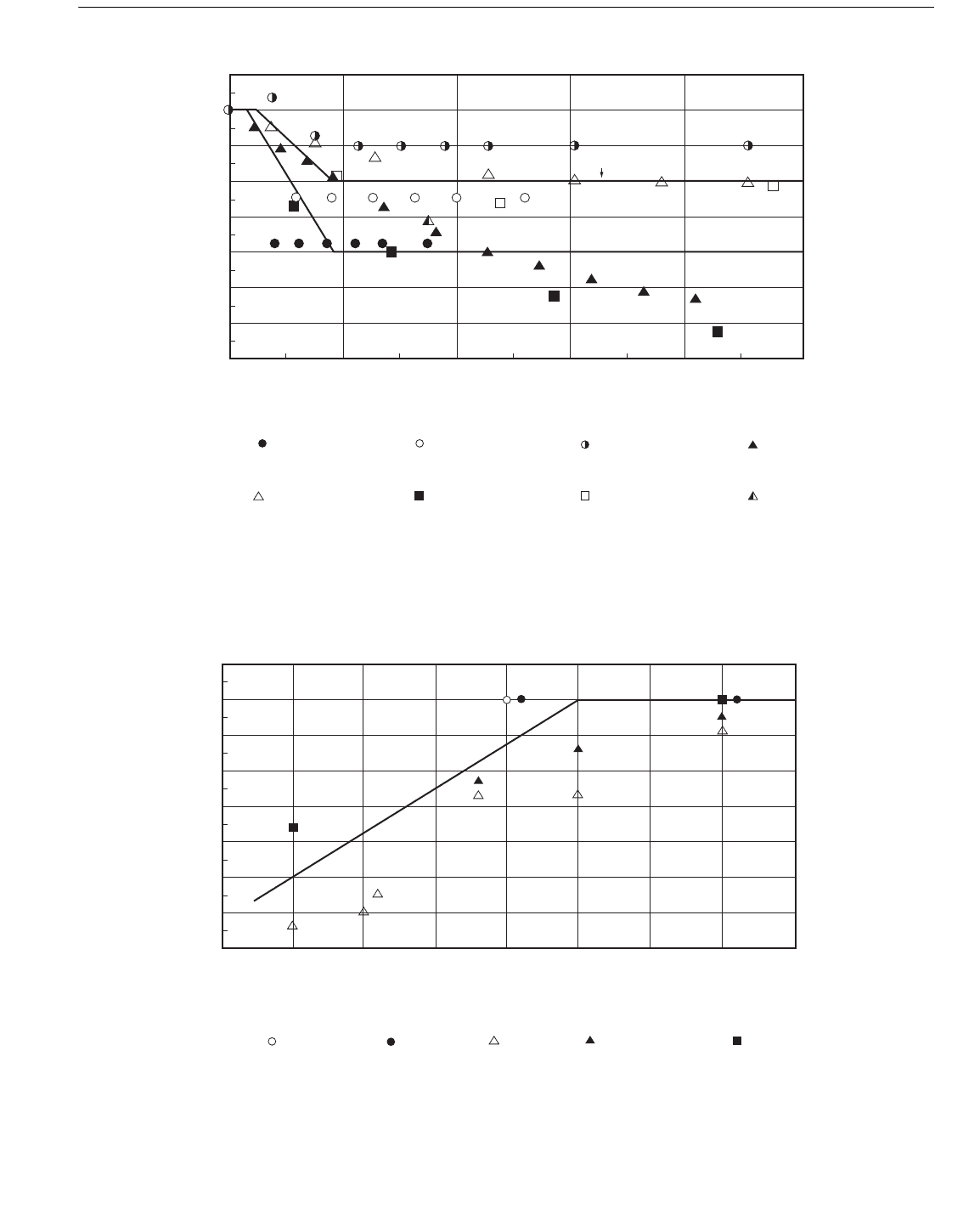
RECOMMENDED PRACTICE FOR PLANNING, DESIGNING AND CONSTRUCTING FIXED OFFSHORE PLATFORMS—WORKING STRESS DESIGN 147
Figure C2.3.1-8—Inertia Coefficient as a Function of K/C
ds
Figure C2.3.1-9—Shielding Factor for Wave Loads on Conductor Arrays as a Function of Conductor Spacing
2.2
2
1.8
1.8
1.4
1.2
1
0.8
0.6
0 20 40 60 80 100
K/CDS
CM
Rodenbusch (1983), CDS = 0.66
Bishop (1985), CDS = 0.66
Rodenbusch (1983), CDS = 1.10
random directional
Rodenbusch (1983), CDS = 0.66
random directional
Rodenbusch (1983), CDS = 1.10
sinusoidal
Heldeman (1975), CDS = 1.00
Heldeman (1975), CDS = 1.68
Ohmart & Gratz (1979), CDS = 0.60
Rough (C
ds
= 1.1)
Smooth (C
ds
= 0.66)
1.1
1
0.9
0.8
0.7
0.6
0.5
0.4
0.3
1.5 2 2.5 3 3.5 5.5
4 4.5 5
S/D
Shielding Factor
Sterndorff (1990)
waves
Beckman (1979)
waves and current
Reed (1990)
current
Reed (1990)
waves (K = 126)
Heideman (1985)
waves (K = 250) and current
Copyright American Petroleum Institute
Provided by IHS under license with API
Licensee=Indonesia location/5940240008
Not for Resale, 10/22/2008 00:07:12 MDT
No reproduction or networking permitted without license from IHS

148 API RECOMMENDED PRACTICE 2A-WSD
Horizontal members in the wave splash zone of an in-place
structure may experience wave slam forces. These nearly ver-
tical forces are caused by the local water surface rising and
slapping against the underside of the member as a wave
passes. Since these forces are nearly vertical, they contribute
very little to the base shear and overturning moment of the
platform. However, slam forces may need to be considered in
local member design.
Slam forces can also occur on platform members over-
hanging the end of the barge while the platform is being
towed, or on members that strike the water first during side
launching of platforms.
In the theoretical case, slam force is impulsive. If the slam
force is truly impulsive, the member may be dynamically
excited. In the real world, the slam force may not be impul-
sive because of the three-dimensional shape of the sea sur-
face, the compressibility of air trapped between the member
and the sea surface, and the aerated nature of water near the
free surface.
Slam force F
S
per unit length can be calculated from the
equation
F
S
= C
s
(w/2g)DU
2
where U is the component of water particle velocity nor-
mal to the member axis at impact. Sarpkaya (1978) has
shown empirically that the coefficient C
s
may lie between 0.5
and 1.7 times its theoretical value of π, depending on the rise
time and natural frequency of the elastically mounted cylin-
der in his tests. Sarpkaya and Isaacson (1981) recommend
that if a dynamic response analysis is performed, the theoreti-
cal value of C
s
= π can be used; otherwise, a value of C
s
= 5.5
should be used.
Axial Froude-Krylov forces have the same form as the
inertia force in Morison’s equation, except that C
m
is set to
unity and the normal component of local acceleration is
replaced by the axial component. Axial Froude-Krylov forces
on members that are nearly vertical contribute negligibly to
platform base shear and overturning moment. Axial Froude-
Krylov forces on diagonal and horizontal braces are relatively
more important, contributing about 10% as much to base
shear and overturning moment as the inertia force included in
Morison’s equation, based on computations performed by
Atkins (1990). In view of approximations made elsewhere in
the computation of global wave force, axial Froude-Krylov
forces can generally be neglected.
References
(1) Achenbach, E., “Influence of Surface Roughness or the
Cross-Flow Around a Circular Cylinder,” Journal of Fluid
Mechanics, Vol., 46, pp. 321–335, 1971.
(2) Achenbach, E., and Heinecke, E., “On Vortex Shedding
from Smooth and Rough Cylinders in the Range of Reynolds
Numbers 6 × 10
3
to 5 × 10
6
,” Journal for Fluid Mechanics,
Vol. 109, pp. 239–251, 1981.
(3) Allender, J. H., and Petrauskas, C., “Measured and Pre-
dicted Wave Plus Current Loading on Laboratory-Scale
Space-Frame Structure,” Offshore Technology Conference,
OTC 5371, 1987.
(4) Atkins Engineering Services, “Fluid Loading on Fixed
Offshore Structures,” OTH 90 322, 1990.
(5) Bearman, P.W., Chaplin, J.R. Graham, J.M.R., Kostense,
J.R., Hall, P.F., and Klopman, G., “The Loading of a Cylinder
in Post-Critical Flow Beneath Periodic and Random Waves,”
Proceedings of Behavior of Offshore Structures Conference,
pp. 213–225, 1985.
(6) Beckmann, H., and McBride, C.M., “Inherent Scatter of
Wave Forces on Submerged Structures,” ASME Petroleum
Division Joint Conference with Pressure Vessels and Piping
Division, Dallas, September 22–25, 1968.
(7) Beckmann, H., and Merwin, J.E., “Wave Forces on Con-
ductor Pipe Group,” Proceedings of ASCE Civil Engineering
in the Oceans IV Conference, September 1979.
(8) Bishop, J.R., “Wave Force Data from the Second
Christchurch Bay Tower,” Offshore Technology Conference,
OTC 4953, 1985.
(9) Blumberg, R., and Rigg, A.M., “Hydrodynamic Drag at
Supercritical Reynolds Numbers,” ASME Conference, June
1961.
(10 )Chappelear, J.E., “Direct Numerical Calculation of
Wave Properties,” Journal of Geophysical Research, Vol., 66,
NO. 2, February 1961.
(11) Dalrymple, R.A., and Heideman, J.C., “Nonlinear Water
Waves on a Vertically-Sheared Current,” E&P Forum Work-
shop, “Wave and Current Kinematics and Loading,” Paris,
October 1989.
(12) Dean, R.G., and Perlin, M., “Intercomparison of Near-
Bottom Kinematics by Several Wave Theories and Field and
Laboratory Data,” Coastal Engineering, Elsevier Science
Publishers B. V., Amsterdam, The Netherlands, 1986.
(13) Det norske Veritas, “Rules for the Design, Construction,
and Inspection of Offshore Structures; Appendix B—Loads,”
1977.
(14) Eastwood, J.W., and Watson, C.J.H., “Implications of
Wave-Current Interactions for Offshore Design,” E & P
Forum Workshop, “Wave and Current Kinematics and Load-
ing,” Paris, October 1989.
(15) Forristall, G.Z., “Kinematics in the Crests of Storm
Waves,” 20th International Conference on Coastal Engineer-
ing, Taipei, 1986.
(16) Garrison, C.J., “Comments on Cross-Flow Principle and
Morison’s Equation,” ASCE Journal of Waterway, Port,
Copyright American Petroleum Institute
Provided by IHS under license with API
Licensee=Indonesia location/5940240008
Not for Resale, 10/22/2008 00:07:12 MDT
No reproduction or networking permitted without license from IHS
